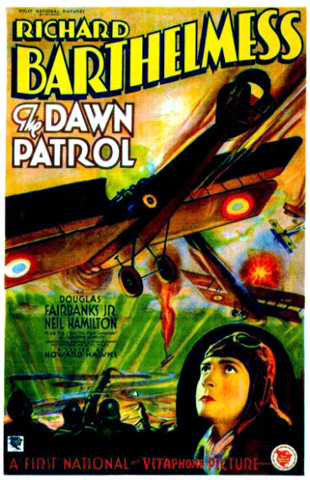I’ll be giving a talk entitled “From Darfur to London: P. R. C. Groves and the construction of aerial apocalypse, 1916-1922”, at the Australian Historical Association’s Biennial Conference, Locating History, 7-10 July 2008, which is conveniently being held at the University of Melbourne. Here’s the abstract:
The idea that cities could be shattered and wars won by aerial bombardment in a so-called ‘knock-out blow’ was embryonic before the Great War. After the war, such exaggerated theories became an orthodoxy among airpower theorists and, by the 1930s, among the wider British public — an important factor underlying support for pacifism, appeasement and collective security up to the Munich crisis. But the war itself was crucial to both the formulation and the propagation of the theory of the knock-out blow.
Most responsible for promoting this idea of the knock-out blow to a wider audience was General P. R. C. Groves, a veteran of both aerial and bureaucratic warfare: the British equivalent of Douhet and Mitchell. Convinced that Britain’s air defences were being dangerously neglected, he retired from the RAF in 1922 and waged a highly-visible press campaign on the issue. In so doing, Groves relied upon and popularised the theory of the knock-out blow, drawing on his experiences in using airpower against rebellion in Darfur, in trying to win the war in France, and in trying to suppress a German resurgence after 1918 — and thereby, ironically, complicated the task of dealing with Germany after 1933.
I wrote that a few months ago, and some of it strikes me as a bit strange now, but I doubt that anyone is going to be tracking how rigorously I adhere to my abstract!
I’m currently slated to talk just after lunch on the first day. I’ve never been before, but it must be Australia’s biggest history conference, with twelve parallel streams. One of these is a war and society-type stream, so I should be right — although the title that’s intriguing me the most is from one of the others: Erin Ihde’s “Do Not Panic: Hawkwind, the Cold War and ‘the Imagination of Disaster'”! I see that fellow bloggers Megan Sheehy and Melissa Bellanta will be giving papers too.
Should be fun.
![]() This work is licensed under a Creative Commons Attribution-NonCommercial-NoDerivatives 4.0 International License.
Permissions beyond the scope of this license may be available at http://airminded.org/copyright/.
This work is licensed under a Creative Commons Attribution-NonCommercial-NoDerivatives 4.0 International License.
Permissions beyond the scope of this license may be available at http://airminded.org/copyright/.






I only know about four Aussie historians: you’re one, and Erin’s another (it’s pronounced ‘Ee-Dee’). Send him my regards.
Thinking about it briefly, I’d say that classic period Hawkwind is more about the _avoidance_ of imagining the apocalypse. Like the way that in Marvel comics and Godzilla movies, exposure to nuclear tests never merely kills you, but instead gives you superpowers. But perhaps this opinion depends on how stoned one was…
I’ve never listened to much Hawkwind, so I’ve got nothing to add. Maybe I’ll have to do some research before the conference …
Owing to Hawkwind’s legendary inability to work out record company deals, their back catalogue is available in about 10^4 different combinations, most of them in compilations largely composed of dire out-takes. Start with _Space Ritual_, then _In Search of Space_, Doremi Fasol Latido, _Astounding Sounds_ and perhaps _PXR5_. After that, it all gets a bit the same.
For airmindednessness, cut straight to the late great Bob Calvert’s _Captain Lockheed and the Starfighers_ which will also explain why I have this daft email address.
Actually, this man here seems to know what he’s talking about, although I can’t vouch for any of his opinions about stuff released after about 1988:
http://www.starfarer.net/hwalbums.html
Thanks! Since he describes it as ‘The greatest album in the world’, if I go down this perilous path I might try Space Ritual …
There are elements of ‘you had to be there – but if you were there, then you probably can’t remember it’ in that album.
Compare and contrast: Moorcock’s own individual post-apocalyptic visions, forex _The War Lord of the Air_ . MM’s solo album ‘New World’s Fair’ is explicitly a ‘WW3 will kill us all’ product [‘Kiss my lips while I still have them/Take my hand and keep it safe’], but his work with Hawkwind was a lot less warscary.
Well, Brett, let’s look out for each other at the conference… It will be good to meet you there. I’m surprised to see that Erin will be talking about Hawkwind, since I thought he was a convict-era historian. I imagine, too, that a whole paper could be written about Groves’ masculinity and its relationship to the theory of the ‘knock out blow’…
Definitely, it would nice to meet a real live blogger!
I could almost have a go at a psychohistorical explanation … I found out that while he was posted to London in 1918, he became engaged to Margot Glyn, the daughter of the novelist Elinor Glyn. I don’t know what happened there, but the engagement was evidently broken off, and in 1920, when posted to Paris he married a Frenchwoman, and lived in France until the late 1920s at least. So I could argue that he became obsessed with the idea of the aerial destruction of the site of his romantic humiliation … but I don’t think I will :)
Pingback: Airminded · Some Tante Jus and a conference report